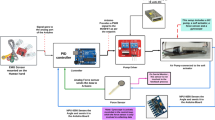Abstract
An innovative tactile sensor is analyzed and verified by intensive experiments. By using micro-cantilever beams, on which the strain gauge layers (Pt/Ti) are deposited, the corresponding induced strains can be detected and converted into electric resistance change, with respect to either applied normal stress or shear stress. The four micro-cantilever beams are allocated in the fashion such that any adjacent beams are perpendicular to each other to decouple any potential measure discrepancy due to non-ideal orthogonality. In addition, the micro-cantilever beams are curled before hands so that they can concurrently detect normal stress and shear stress. To be protected from being damaged by strong stress, the curled cantilever beams are covered up by elastomer material. Therefore, the micro-tactile sensor can detect normal stress up to 250 kPa and shear stress up to 35 kPa. Besides, since the elastomer is made of PDMS, which is of high bio-compatibility, the tactile sensor can be used to directly contact with human body. By taking the design and fabrication parameters into account, the curled micro-cantilever beams, which is of multi-layer structure by polymer/Pt/Ti/Si, can be produced with high yield rate. Finally, the efficacy of the tactile sensor is verified by experiments via a micro-manipulator, a high-resolution microscope and a force sensor for calibration.













Similar content being viewed by others
References
Bruce A, Nourbakhsh I, Simmons R (2002) The role of expressiveness and attention in human–robot interaction. In: Proceedings of the IEEE International Conference on Robotics Automation, Washington DC, pp 4138–4142, 11–15 May 2002
Hasegawa Y, Shikida M, Ogura D, Sato K (2007) Glove of wearable tactile sensor produced by artificial hollow fiber, Digest Tech. Pap., Transducer 07, Lyon, pp 1453–1456, 10–14 June 2007
Hosokawa K, Shimoyama I, Miura H (1996) Two-dimensional microself-assembly using the surface tension of water. Sens Actuators A 57:117–125
Huang YM, Sohgawa M, Noda M, Yamashita K, Kanashima T, Okuyama M, Noma H (2006) Studies on curvature deformation control of bilayer cantilever fabricated by surface micromachining of SOI wafer. In: Mater Res Soc Symp Proc, vol 969. Boston, MA, Nov 27–Dec 1, 0969-W05-01
Kanehiro F, Kaneko K, Fujiwara K, Harada K, Kajita S, Yokoi K, Hirukawa H, Akachi K, Isozumi T (2003) The first humanoid robot that has the same size as a human and that can lie down and get up. In: Proceedings of the IEEE International Conference on Robotics and Automation, Taipei, pp 1633–1639, 14–19 September 2003
Leineweber M, Pelz G, Schmidt M, Kappert H, Zimmer G (2000) New tactile sensor chip with silicone rubber cover. Sens Actuators A 84:236–245
Noda K, Hoshino K, Matsumoto K, Shimoyama I (2005) 300 nm-thick cantilever in PDMS for tactile sensing. In: IEEE micro electro mechanical systems, Miami Beach, FL, pp 283–286, January 30–February 3 2007
Noda K, Hoshino K, Matsumoto K, Shimoyama I (2006) A shear stress sensor for tactile sensing with the piezoresistive cantilever standing in elastic material. Sens Actuators A 127:295–301
Ogawa G, Sugiyama N, Kanda M, Okano K (2005) Perfluoro transparent resin “Cytop”—some physical properties and kinetic studies on radical polymerization reaction. Reports Res Lab Asahi Glass Co., Ltd., vol 55, pp 47–51
Roos L, Guenter F, Guignard A, Billard GA (2006) Design of a biomimetic spine for the humanoid robot robota. In: IEEE/RAS-EMBS International Conference on Biomed. Rob. Biomec., Pisa, 20–22 February 2006
Schmid U, Seidel H (2008) Effect of high temperature annealing on the electrical performance of titanium/platinum thin films. Thin Solid Films 516:898–906
Sohgawa M, Noda M, Huang YM, Yamashita K, Kanashima T, Okuyama M, Noma H (2006) Studies on deflection control of bilayer cantilever fabricated by surface micromachining process on SOI wafer. In: Proceedings of 23rd Sensor Symposium, Takamatsu, pp 165–169, 5–6 October 2006
Wen CC, Lin CM, Fang W (2007) 3-Axes tactile sensor with tunable sensing range, Digest Tech. Pap., Transducer 07, Lyon, pp 1457–1460, 10–14 June 2007
Wisitsoraat A, Patthanasetakul V, Lomas T, Tuantranont A (2000) Low cost thin film based piezoresistive MEMS tactile sensor. Sens Actuators A 139:17–22
Wortman JJ, Evans RA (1964) Young’s modulus, shear modulus Poisson’s ratio in silicon and germanium. J Appl Phys 36:153–156
Yoshida S, Mizota T, Noma H (2007) Development of an integrated multi-axis tactile sensor: distributed preprocessing for tactile recognitions. In: IEEE-virtual reality, Charlotte, NC, 10–14 March 2007
Acknowledgments
The authors would like to thank National Nano Devices Laboratory (NDL) and Chip Implementation Center (CIC) for equipment access and technical support. This research was partially supported by National Science Council (Taiwan) with Grant NSC98-2221-E-006-050.
Author information
Authors and Affiliations
Corresponding author
Rights and permissions
About this article
Cite this article
Huang, YM., Tsai, NC. & Lai, JY. Fabrication and performance assessment of a novel stress sensor applied for micro-robotics. Microsyst Technol 16, 1719–1725 (2010). https://doi.org/10.1007/s00542-010-1091-z
Received:
Accepted:
Published:
Issue Date:
DOI: https://doi.org/10.1007/s00542-010-1091-z




